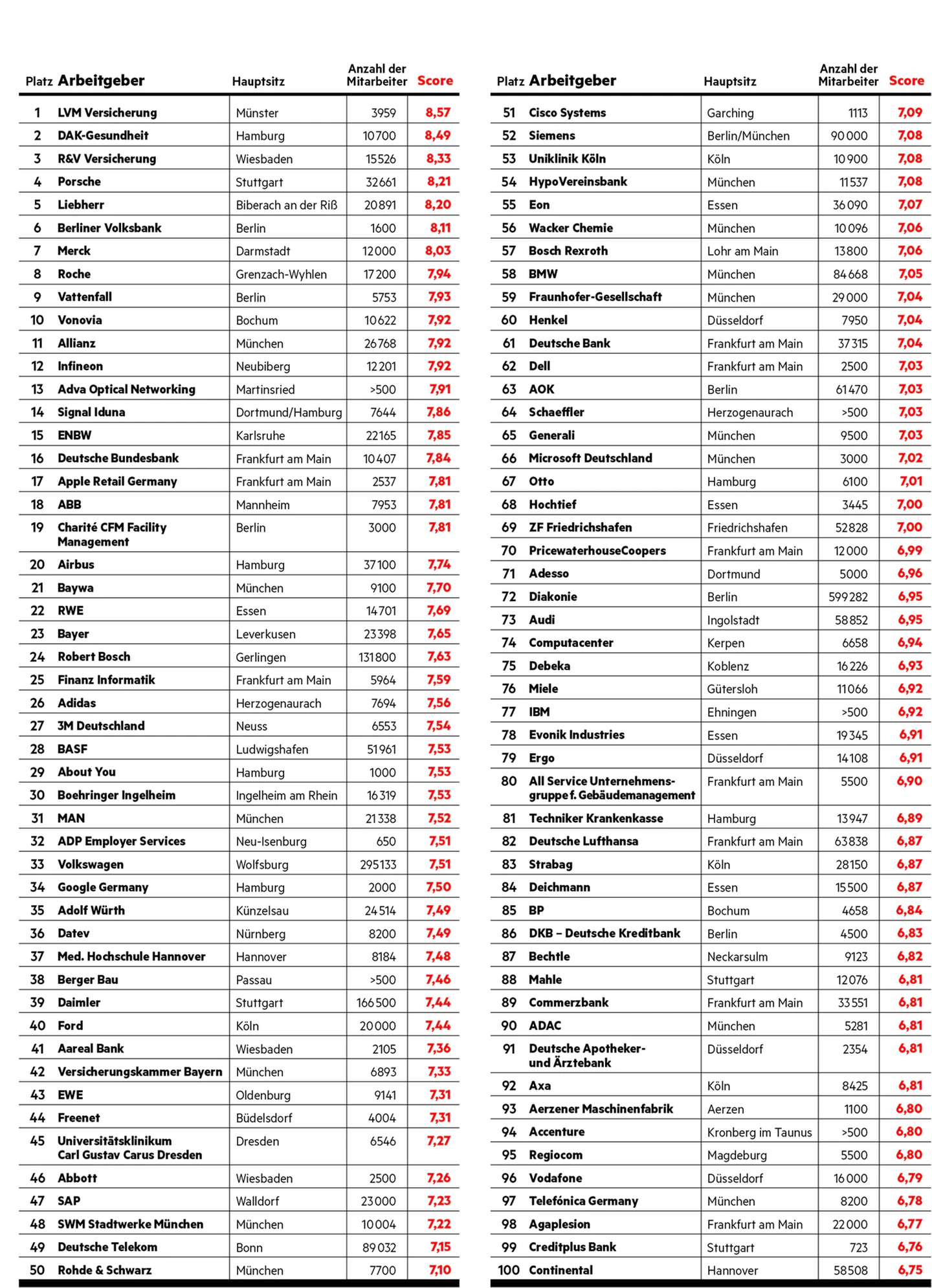Can the employer educate us at lunch? A conversation with canteen expert Holger Pfefferle. Plus: a ranking of health-conscious companies.
Mr. Pfefferle, VW has removed currywurst from the menu in a canteen? Right?
I find that at least questionable. This does not correspond to the principles of the German Society for Nutrition. We are against decreeing waivers or banning food. Our philosophy is to expand the offer and give more choices.
When people have the choice, they like to eat currywurst. It is one of the most popular canteen dishes.
It’s part of our culture. You have to pay attention to the wishes of the canteen guests. People only come if they like it. That’s why I wouldn’t think about whether, but rather how to offer the currywurst and what alternatives there are.
Belonging to the whole truth: VW has only converted one canteen to vegetarian dishes. A few steps away it’s all about the sausage.
You can easily accommodate a currywurst in a good, balanced diet. It shouldn’t be there every day. It’s less about the individual dish and more about the average over the week or the whole month.
Is the currywurst the main problem or the fries with it?
Sure, with French fries red and white you are not far ahead in terms of nutrition. However, we do not generally exclude breaded or fried foods from our menu recommendations. It depends on the dose. But of course you can prepare a lot with less fat. The sausage also loses fat if you grill it properly. The lion’s share of lunch should consist of plant-based foods such as vegetables, lettuce, legumes, whole wheat pasta, rice, potatoes and fruit.
Should health-conscious employers try to educate their employees?
No. The catering is part of the company health promotion. It’s about occupational safety, addiction prevention, exercise and stress management, but also nutrition. A good canteen can promote awareness of healthy eating. Employees should be guided, but not manipulated.
How does that work specifically?
With a nudge. Experts speak of nudging. You can light up the salad bar brighter. Or place fruit instead of chocolate bars in front of the tills. I know a company that deliberately reduced the number of deep fryers when rebuilding the kitchen. When the queues for currywurst with fries get a little longer, fewer people line up.
Isn’t that a permanent conflict of goals: The food should be healthy, but also popular.
I advise companies to take a fundamental look at the topic first. It’s not just about the food, it’s also about the surroundings. What should the canteen be? The company restaurant can be a place of communication, social participation and relaxation. I have to create the conditions for this and then develop the corresponding offer. And who says that a popular meal can’t be healthy at the same time? Here chefs can let their creativity run free and combine both.
Does an attractive employer need a good canteen these days?
An economically healthy company can often be recognized by the company restaurant and how much the food costs. Many younger specialists today ask their potential employer: What do you offer me? Pay and work-life balance are probably the most important things, but the canteen is also a factor in attracting employees.
Hasn’t Corona changed that?
Part-time work and working from home have already increased. It is becoming increasingly rare that people work eight hours a day, five days a week. The pandemic has reinforced this trend. This has consequences for the canteens. Your role changes.
In what way?
The frequency of going to the canteen is falling and its importance is increasing. If many work in the home office, the few opportunities for personal exchange become even more important. In the first phase of the pandemic, most of them suffered massively from the fact that social contacts at work were lost.
Do you know how the Germans fed themselves in the home office?
There are no studies on this, we can only speculate. Apparently, the delivery services have benefited enormously. Working from home doesn’t automatically mean that you have time to cook when one meeting follows the next. Many people find cooking to be a lot of work. This is where I see an opportunity for company restaurants: for example, by providing the option of taking food home and then having dinner with the family.
They certify companies under the motto “Job & Fit”. What do they have to do about it?
A lot! What is important is the quality and quantity of the right food, nutrient-friendly preparation and a low degree of processing of the food. It is also necessary to communicate with the guest about this. It is also important that wholesome vegetarian dishes are always offered.
What does that mean?
It shouldn’t just be side dishes that might have a diced bacon floating in them. Wonderful main dishes can be created with lentils, chickpeas or soybeans. But here, too, we take a critical view of highly processed meat substitutes. Something like pea protein or soy burger patties should only be served once a week.
To come back to the hit parade of the most popular dishes: in addition to the currywurst, there are spaghetti bolognese…
This is an ingenious dish that you can prepare sustainably and health-promoting without any major problems. I can eat little lean meat and lots of vegetables. It is also possible to replace the mince entirely with soy or red lentils. Thanks to the roasting substances, it is almost impossible to tell the difference. And if I also choose whole grain pasta that doesn’t have to be dark colored, then I’m on the perfect way.
The breaded fish is also on the hit list, often on Fridays.
Because of overfishing, we have become more cautious about fish. Sea fish used to be called in once a week. Today we also accept freshwater fish. Breading is allowed, but not every day. Instead of remoulade, lighter products can be used, such as a sour cream with fresh herbs. The potato salad can also be prepared with vinegar and broth instead of mayonnaise.
And then there’s the pizza, which is often dripping with fat thanks to salami and cheese.
Even a pizza doesn’t have to be a calorie bomb. The dough can be prepared with wholemeal flour. The tomato sauce does not have to come from the bag, but can be made yourself with olive oil and herbs. And when it comes to cheese, it also tastes good with cream cheese or feta. And last but not least: It doesn’t always have to be salami. Lean boiled ham is a low-fat alternative, and pizza is a delicious dish even without meat. Raw food is best served with it. The guest decides whether she is chosen.
Mr. Pfefferle, thank you very much for the interview.
One moment please. I have a request for all canteen guests: Please give me some praise! Say: The savoy cabbage yesterday was to die for. Then the kitchen team works even harder the next day.
health conscious companies

health conscious companies
© star
The method: How the ranking was determined
study
The research partner is the renowned market research company Statista. More than 50,000 employees took part in a survey via the Internet using high-quality online access panels: companies with at least 500 employees in Germany could be evaluated. In advance, Statista had researched a list of more than 2,600 larger employers in 24 industries. The respondents could also name other companies. The brand with which the companies appear in public and advertise for employees was evaluated in each case. Despite the great effort and great care, the ranking does not claim to be complete. The survey took place between June 24 and August 9, 2021.
The companies were assessed in eight dimensions: management culture & motivation, working atmosphere, workplace & equipment, work-life balance, workflow, working hours, colleagues, health problems & hygiene concept. Measures for workplace health promotion (e.g. offers for healthy eating in the canteen or nutritional advice) were then surveyed and evaluated. Finally, the participants were able to assess how their working conditions affect their health. In addition, the HR departments of well-rated companies received a questionnaire on health-related processes and measures (e.g. employee participation or courses during working hours). This survey took place between September 23 and November 16, 2021.
rating
The results were converted into a score between zero and ten. If company responses were available, they counted for 30 percent and employee responses for 70 percent. In the other cases, only the employee score counts. The eight health dimensions make up 70 percent and the additional questions on workplace health promotion and one’s own health make up 30 percent. 100 above-average companies are awarded.
transparency
The stern editorial team only works with test partners with a high level of expertise. Statista brings this with her. The independent market research institute works for a large number of clients. However, the neutrality of data collection and analysis is always guaranteed. No company was able to apply to participate in the study or influence inclusion on the list. The stern editorial team decided on the questionnaire and the evaluation scheme. The winners have the opportunity to acquire a star seal for their public image. More detailed information on the conditions of these seals can be found at www.stern.de/siegel



